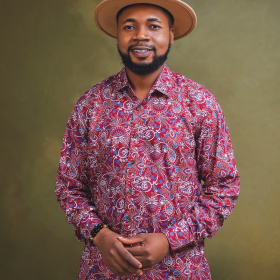Shut up and play the kora
It must be difficult lugging the kora around. The thought, to the uninitiated, is this: why bother? And yet, that thought is first thing to flee the mind once the instrument, in the hands of gifted player, yields its music.
On Thursday 11 June the kora brought forth its music at the Centre for Contemporary Art (CCA) in Lagos, an art space neither funded enough nor big enough for what it provides artists looking to showcase work. The event, tagged Truth & Art, featured a couple: English filmmaker Sunara Begum and musician Tunde Jegede.
 Tunde Jegede
Tunde Jegede The audience at the recent Truth & Art event at the CCA in Lagos.
The audience at the recent Truth & Art event at the CCA in Lagos. Tunde Jegede performing at Truth & Art at the CCA in Lagos.
Tunde Jegede performing at Truth & Art at the CCA in Lagos.
Jegede, Artistic Director Music Society of Nigeria (MUSON), brought a number of his students; his students brought a number of music instruments. And the audience brought curiosity. CCA had advertised film, music and art. How would it all play out?
Simple enough. When you walked into the second floor of the building, you encountered the installation; the film plays when you sit down; afterwards Jegede and his boys—call them Jegede and the Joys—play music. This order comes in hindsight. It wasn’t announced. And good, too. The newbie is ambushed by beauty. The initiated is pacified by same.
At first, and perhaps becomes it is encountered first, the weakest bit of the three components, it must be said, are the three short films making up the 'Truth & Art' series. Each is dedicated to a music artist: singer and flautist Diana Baroni, kora player and cellist Tunde Jegede, and guitarist and folklorist Derek Johnson.
Directed by Begum, who is of Bangladeshi descent, the short, often confounding films are a measure of spousal support. You get the feeling that if the director could she’d include her partner in every shot. Filmed against the light or with the full glare of blessed sun rays, Jegede’s image attains a superhuman substance. Light isn’t around him as much as pouring forth from him. He illuminates the film. The romantic may take a leap off-screen: he illuminates her life. So that when a talking head in the series suggests that Jegede is an ancient spirit, stopping short of uttering reincarnation, it is not hard to imagine.
Begum’s exquisite cinematography makes it so we are liable to accepting this quasi-blasphemy. And by the time those words turn up in the film, Begum has made the point repeatedly with the camera. Sitting and watching this with the couple inches away gives a heightened effect of voyeurism. It recalls a line from TS Eliot to his wife: “But this dedication is for others to read: These are private words addressed to you in public.”
The somewhat experimental form of the trio of short films means nary a consideration is given to narration. Talking heads talk, the centrepiece of the collection, named after titular character Tunde Jegede, features the hero’s clarification of his art. A clarification which only adds to the befuddlement of the viewer. Art is essentially unknowable, and in the case of Jegede, his wife presents that mystery as currency. Pity then that that currency is unserviceable for viewers yet to see Jegede perform. That was corrected at the end of event when Jegede’s fingers happened on the kora’s strings.
Before Jegede’s performance, the audience rose for chatter and Begum’s installation. The installation comprised small calabashes suspended from the ceiling half-filled with earth. Within these vessels were 2-sided black and white photos. Artists, activists, writers, politicians, Malcolm X, Frida Kahlo, Sankara et al adorned these photos. Name of the installation? 'Floating Icons'. Tunde Jegede’s face peeped out of one of these photos.
Combined with the films, particularly one on Derek Johnson, discussing his book on the roots of African-American classical music, ‘Floating Icons’ is a homage and static celebration of some of humankind’s finest people, a literal representation of sons and daughters of the soil. Humans of the salt-of-the-earth variety. Asked why a portion of the screened films were devoted to the USA, Jegede responded, “It is difficult not to acknowledge American when you are looking at music.”
Chattering over, the audience resettled for Jegede’s performance. He started off with 'Sahel’s Call', a piece inspired by Malian music. Excellent music; yet it wasn’t until ‘Evocations’, played in tandem with his students, that audible gasps could be heard from the audience. “They played it very well,” he said of his students afterwards. The same could be said of Jegede himself. In fact, as he played the music, one began to understand Begum’s lens’s obsessive fascination with the man. There is a kind of brilliance doused by intimacy. Jegede’s brilliance with the kora is not that kind.



































Comments
Log in or register to post comments